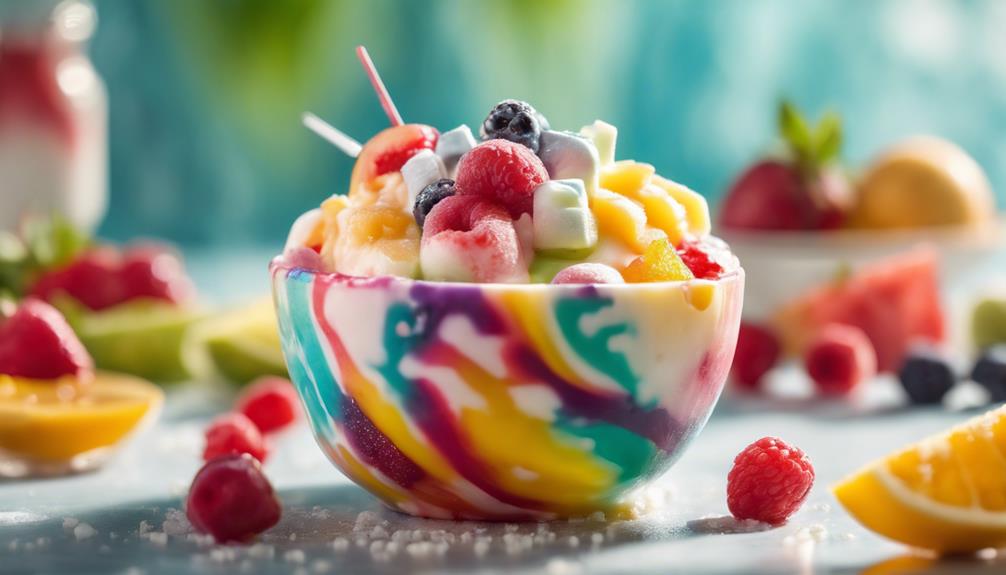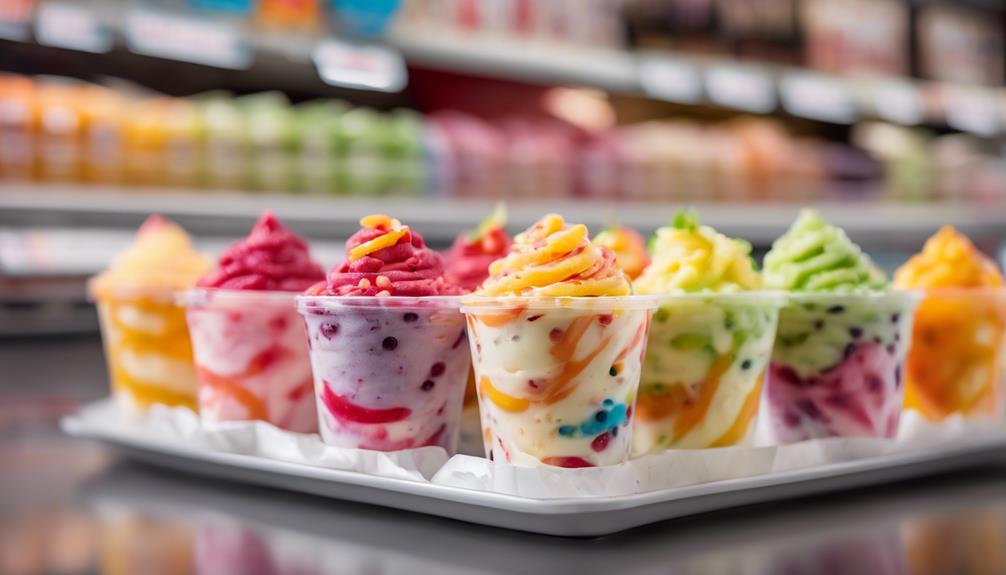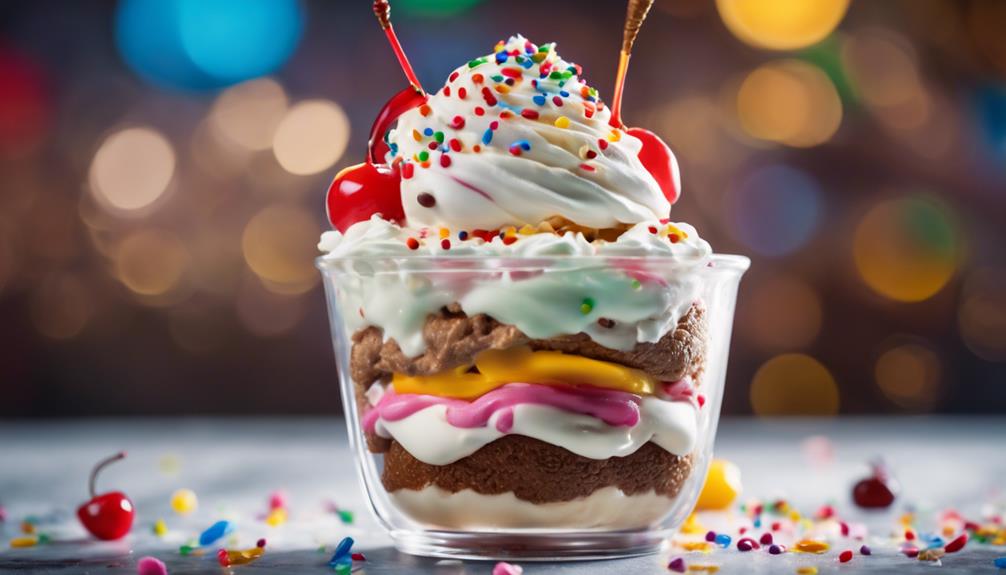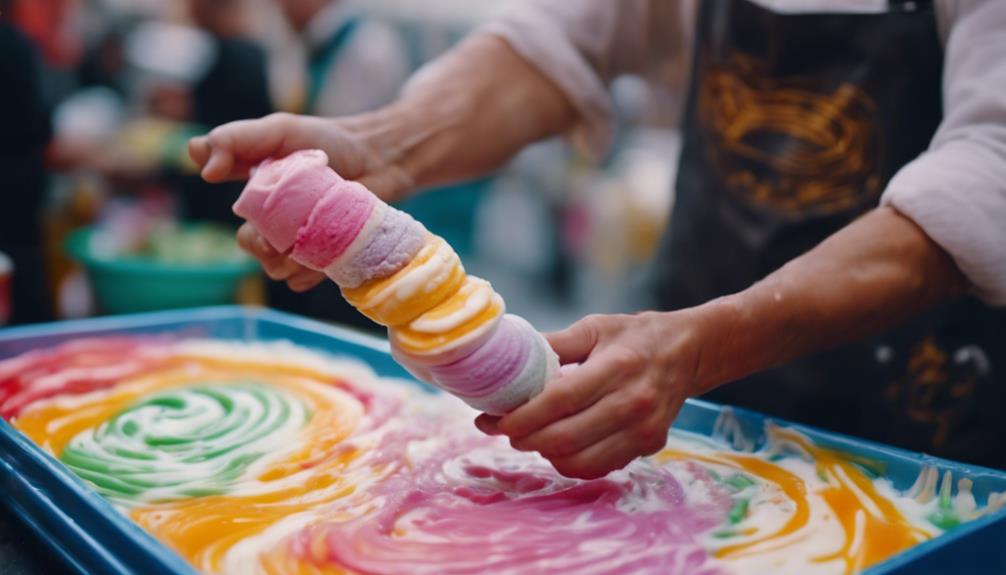Frozen yogurt typically contains between 13 to 22 grams of sugar in a half-cup serving. If you decide to go for a larger portion, like a 16-ounce cup, that sugar content can jump to around 80 grams. It’s crucial to review the nutrition label of each flavor because some, particularly dessert varieties, may have even higher sugar content. Additionally, toppings can contribute an extra 5 to 20 grams of sugar. For healthier options, choose varieties with no added sugars or lower overall sugar content. If you’re interested in learning how to enjoy your frozen treat without consuming excessive sugar, there’s more to explore.
Key Takeaways
- Frozen yogurt typically contains 13 to 22 grams of sugar per half-cup serving, depending on the flavor.
- A full 16-ounce serving can have around 80 grams of sugar, much higher than traditional ice cream.
- Sugar content varies by flavor; fruit options are generally lower than chocolate or dessert flavors.
- Toppings can add an additional 5 to 20 grams of sugar, significantly increasing overall intake.
Overview of Sugar Content
When it comes to frozen yogurt, you might be surprised to learn that the sugar content typically ranges from 13 to 22 grams per half-cup serving, depending on the flavor and brand. While many people choose frozen yogurt because it's often marketed as lower in fat, this doesn't always mean it's healthier.
In fact, many varieties have sugar added to enhance flavor, which can lead to surprisingly high sugar levels. For instance, a full 16-ounce serving can pack around 80 grams of sugar, considerably more than a scoop of traditional ice cream. This can be particularly concerning if you're trying to monitor your sugar intake.
When visiting self-serve frozen yogurt shops, it's easy to underestimate how much sugar you're consuming, especially if you opt for a larger serving size. To make informed choices, you should always check the nutritional information on the labels.
Sugar content varies widely between different brands and flavors, so taking a moment to read the details can help you avoid unexpected sugar overload. Being aware of these factors lets you enjoy frozen yogurt without compromising your health goals.
Nutritional Comparison With Ice Cream

Frozen yogurt often seems like a healthier choice, but its sugar content can rival or even exceed that of traditional ice cream. A typical half-cup serving of frozen yogurt packs 13 to 22 grams of sugar, while a similar serving of ice cream usually contains about 10 to 15 grams. If you indulge in a full 16-ounce serving of frozen yogurt, you could be consuming around 80 grams of sugar, considerably higher than a scoop of ice cream, like Ben & Jerry's, which has about 20 grams.
While frozen yogurt is often marketed as a lighter alternative, flavored varieties can have comparable or even higher sugar content than ice cream. You might appreciate the lower fat content of frozen yogurt, but those added sugars can negate any potential health advantages.
It's essential to be mindful of portion sizes; larger servings of frozen yogurt can lead to much higher sugar intake compared to a standard scoop of ice cream. So, the next time you're choosing between the two, consider the sugar content carefully to make a more informed decision about your treat.
Health Benefits of Frozen Yogurt

While sugar content can be a concern, frozen yogurt also offers several health benefits that make it an appealing dessert choice.
You'll find that indulging in frozen yogurt can be a smart option for those looking to satisfy their sweet tooth without overloading on calories.
Here are some of the key health benefits of frozen yogurt:
- Contains live cultures: These probiotics support gut health and digestion.
- Lower calories: Typically, frozen yogurt has fewer calories and less fat than traditional ice cream.
- Good source of calcium: Many varieties provide essential nutrients for strong bones.
Choosing frozen yogurt allows you to enjoy a delicious treat while reaping potential health benefits.
The presence of live cultures not only enhances flavor but also plays a role in maintaining your overall well-being, such as lowering blood pressure and boosting your immune function.
Sugar Variations by Flavor
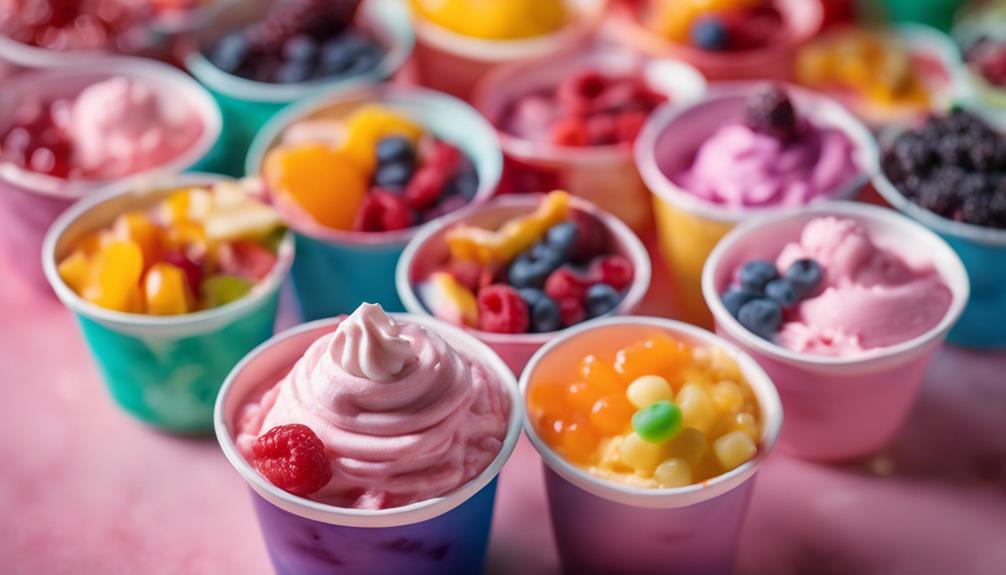
When you choose a flavor of frozen yogurt, you're likely picking a different sugar content too.
Flavors like chocolate and cookie dough can pack a sugary punch, while fruity options may offer a lighter alternative.
Don't forget to check for seasonal varieties and low-sugar options that can help you enjoy tasty treats without the extra sweetness.
Flavor-Specific Sugar Content
Sugar content in frozen yogurt varies widely by flavor, with fruit options usually containing 13 to 22 grams per half-cup serving. If you're a fan of chocolate or dessert-inspired flavors, be prepared for higher sugar levels, often exceeding 22 grams per serving. This means that the flavor of frozen yogurt you choose greatly influences your overall sugar intake.
To help you navigate your choices, here are some key points to reflect on:
- Fruit Flavors: Generally range from 13 to 22 grams of sugar.
- Chocolate/Dessert Flavors: Often exceed 22 grams of sugar per serving.
- No-Sugar-Added Options: Can contain as little as 5 grams of sugar, perfect for health-conscious consumers.
Seasonal Variation Effects
Seasonal flavors like Pumpkin Spice and Eggnog can surprise you with their higher sugar content, often ranging from 15 to 25 grams per serving. These limited-time offerings may include additional sweeteners or flavorings that elevate the overall sugar content, so it's essential to check nutritional labels before indulging.
Fruity seasonal flavors, such as Berry Ruby, can also vary considerably in sugar levels, with some containing up to 22 grams of sugar per half-cup serving. If you're enjoying these festive treats, be mindful of the toppings you choose. Holiday-themed additions like sweetened whipped cream or candy pieces can greatly increase the sugar content.
Additionally, portion size plays an important role in your overall sugar intake. During seasonal promotions, it's easy to opt for larger servings, which can lead to a considerable increase in sugar consumption. A 16-ounce cup may contain over 80 grams of sugar if you're not careful.
Low-Sugar Flavor Options
Exploring low-sugar flavor options can lead you to delicious frozen yogurt choices that satisfy your cravings without overwhelming your diet. Many brands offer options with only 4 to 7 grams of sugar per half-cup serving, making them ideal for health-conscious consumers. These flavors often steer clear of additional sugar that can sneak in through syrups and sweeteners.
When you're at the yogurt shop, consider the following low-sugar flavor options:
- Vanilla
- Chocolate
- Strawberry
It's also wise to check if they've no-sugar-added varieties, which maintain sweetness without extra sugar.
Keep in mind that toppings can greatly impact your sugar intake too. Instead of loading up on sugary syrups and candy, opt for fresh fruit or nuts to enhance your frozen yogurt.
This way, you'll enjoy a satisfying treat while keeping your sugar levels in check. Next time you indulge, remember that choosing low-sugar flavor options and mindful toppings can help you enjoy your frozen yogurt guilt-free!
Portion Sizes and Serving Suggestions
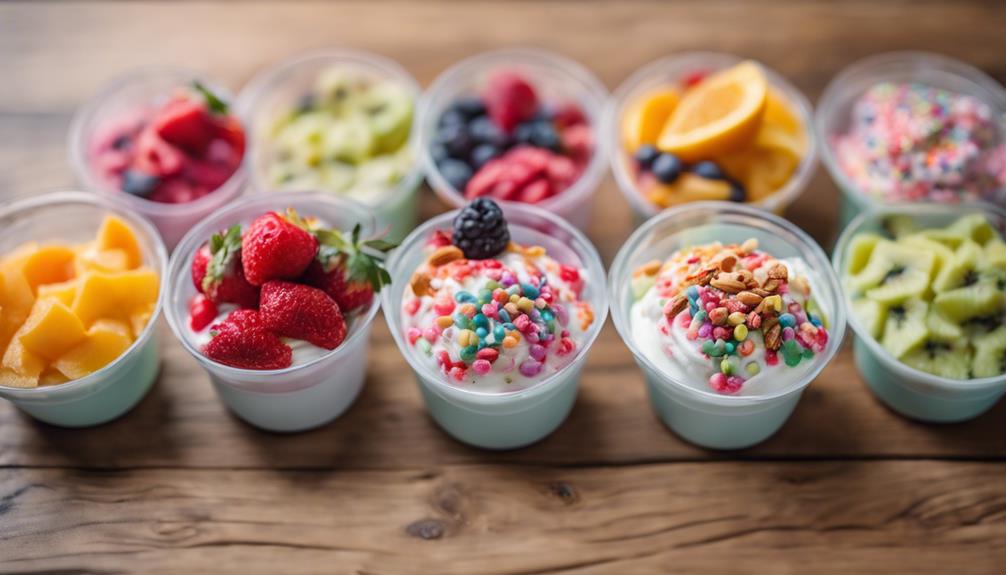
When you're enjoying frozen yogurt, it's essential to pay attention to portion sizes.
Many shops might trick you into thinking you're getting a small serving, but those ounces can add up quickly.
Being aware of the caloric impact and choosing recommended portion sizes can help you manage your sugar intake effectively.
Understanding Serving Sizes
Understanding serving sizes is essential for managing your calorie and sugar intake when enjoying frozen yogurt. Many frozen yogurt shops can be misleading, as what seems like a small cup might actually contain 1.5 servings. When you're enjoying a self-serve location, it's easy to lose track of how much you're consuming because they often charge by the ounce.
Consider these key points about serving sizes:
- A half-cup serving usually has 90 to 120 calories and 13 to 22 grams of sugar.
- A full 16-ounce serving can pack around 500 calories and 80 grams of sugar.
- Opting for pre-determined cup sizes helps maintain better control over your intake.
Recommended Portion Control
Maintaining portion control is essential for enjoying frozen yogurt without overindulging in calories and sugar. A typical serving size is around half a cup, which usually contains about 90 to 120 calories and 13 to 22 grams of sugar. However, many frozen yogurt shops provide larger cup sizes, leading to servings that can exceed 16 ounces, packing in as much as 500 calories and 80 grams of sugar.
To effectively manage portion control, it's smart to opt for smaller, pre-determined cup sizes instead of self-serve options, where you pay by the ounce. This helps you avoid those hefty servings that can sneak up on you. Additionally, be cautious of misleading serving size labels; brands like Pinkberry and TCBY often base their nutrition facts on half-cup servings, but your actual serving may be much larger.
If you're at a self-serve shop, consider weighing your yogurt to better understand and control your calorie and sugar intake. By practicing these portion control strategies, you can savor your frozen yogurt treat without the guilt of overindulgence.
Caloric Impact Awareness
Awareness of caloric impact is key to making informed choices about portion sizes and enjoying your frozen yogurt without overloading on calories and sugar.
Frozen yogurt can have fewer calories than ice cream, but larger servings can quickly add up, especially when you're not mindful of portion control. A mere half-cup often contains 90 to 120 calories, but a full 16-ounce serving can skyrocket to around 500 calories and 80 grams of sugar.
To keep your indulgence in check, consider these tips:
- Choose smaller, pre-determined cup sizes instead of opting for self-serve options.
- Be mindful of toppings; they can greatly increase both calories and sugar.
- Remember that lower fat doesn't always mean lower calories; check the nutritional facts.
Impact of Toppings on Sugar Levels
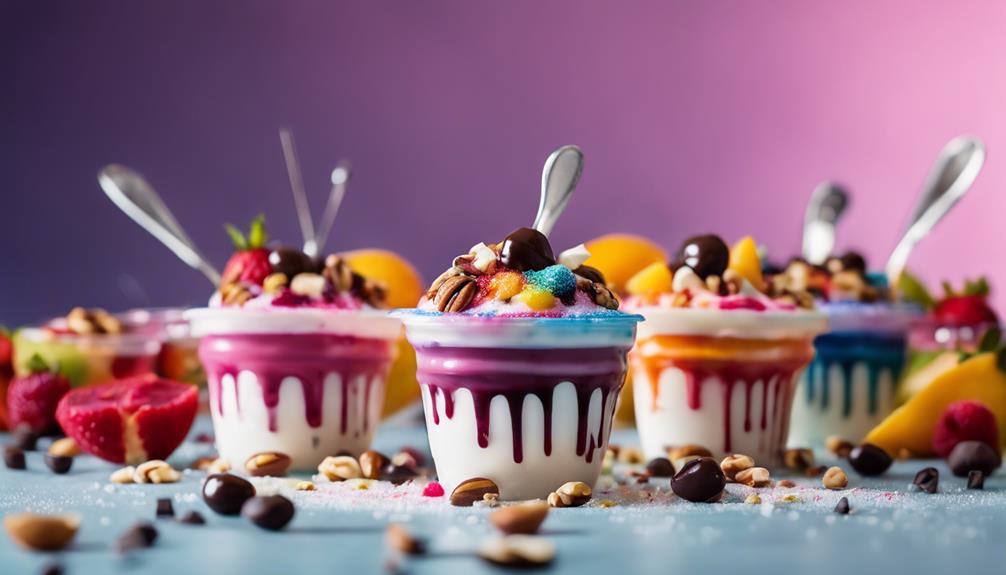
Toppings can dramatically boost the sugar content of your frozen yogurt, often adding an extra 5 to 20 grams per serving. When you visit a toppings bar, you might be tempted by the colorful array of options, but it's important to understand how they affect your overall sugar intake.
Here's a quick breakdown of some common toppings and their sugar contributions:
| Topping Type | Estimated Sugar Content (grams) |
|---|---|
| Candy (e.g., gummies) | 10 – 15 |
| Sweetened Syrups | Up to 15 |
| Sweetened Fruit | 5 – 10 |
Common toppings like granola or sweetened coconut can add an extra 10 to 15 grams of sugar to your frozen yogurt. Even seasonal fruit, while often perceived as a healthier choice, can still contribute around 5 to 10 grams of sugar depending on the type and quantity. With a standard half-cup serving of frozen yogurt already containing 13 to 22 grams of sugar, it's easy to see how quickly your sugar content can escalate with just a few toppings.
Choosing Healthier Options

When you're choosing frozen yogurt, look for options that have lower sugar content, ideally around 13 grams or less per half-cup serving. This helps you enjoy a delicious frozen treat without overloading on sugar. Additionally, you can opt for varieties labeled as 'no sugar added' to further reduce your intake while still satisfying your sweet tooth.
Here are some tips for making healthier choices:
- Choose toppings like unsweetened fruit or nuts instead of sugary syrups or candies.
- Pay attention to portion sizes; stick to about half a cup to manage calorie and sugar intake.
- Always check the nutrition labels for specific sugar content and ingredients.
Understanding Labels and Ingredients
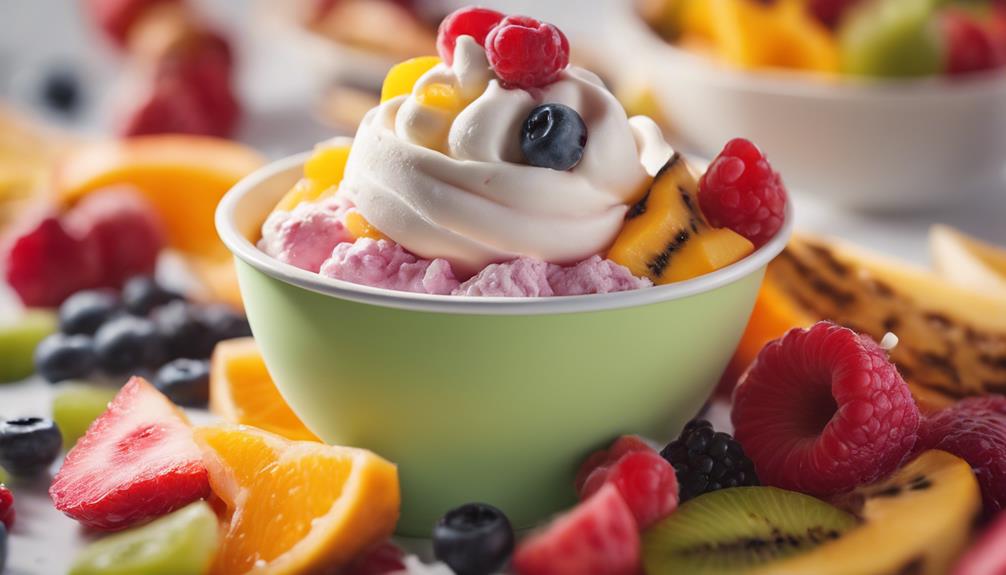
Understanding the labels and ingredients on frozen yogurt can help you make informed choices about sugar content and overall quality. When you look at a label, pay close attention to the sugar content, which can vary considerably. A half-cup serving may contain anywhere from 13 to 22 grams of sugar. It's essential to check if the brand includes added sugars, as these can elevate the total sugar content beyond the natural sugars found in dairy.
You might also encounter options labeled as no-sugar-added, but don't skip the ingredient list. Some brands may use artificial sweeteners or thickeners that you may want to avoid. Additionally, look for the mention of live and active cultures; these can provide potential probiotic benefits.
Here's a quick reference table to help you navigate:
| Frozen Yogurt Type | Sugar Content (grams) | Live & Active Cultures |
|---|---|---|
| Regular | 13 – 22 | Yes |
| No-Sugar-Added | 0 – 5 | Check label |
| Low-Fat | 10 – 18 | Yes |
| Non-Dairy | 8 – 15 | Check label |
| Premium | 15 – 25 | Yes |
Frequently Asked Questions
Is Frozen Yogurt High in Sugar?
Yes, frozen yogurt can be high in sugar. Depending on the brand and flavor, you might find it contains significant amounts, especially if you choose larger portions at self-serve shops. Always check the nutritional labels!
Is Frozen Yogurt Healthy or Unhealthy?
Frozen yogurt's a tempting mirage in the dessert desert, but don't be fooled. It can pack hidden sugars, making it less healthy than it seems. Always check labels to verify you're making a smart choice.
Is Frozen Yogurt Ok for Diabetics?
Frozen yogurt can be enjoyed by diabetics if you choose no-sugar-added options and practice portion control. Always check nutritional labels and consult your healthcare professional for personalized advice on incorporating it into your diet.
What Has More Sugar Gelato or Frozen Yogurt?
Imagine a sweet dance; frozen yogurt often twirls close to gelato. Generally, frozen yogurt's sugar content can rival gelato's, so you should check labels and choose wisely to enjoy your treat without overindulging.
Conclusion
In the end, steering through the sugar content in frozen yogurt is like exploring a sweet labyrinth.
By understanding the nutritional facts and making mindful choices, you can indulge without the guilt.
Remember to watch portion sizes and be cautious with toppings, as they can turn your treat into a sugary avalanche.
So, savor each delightful spoonful, but keep an eye on those sugar levels to guarantee your treat remains a pleasure, not a burden.
